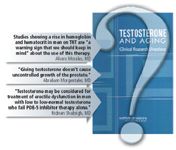Article
Efficacy and safety of TRT still raises questions
Knowledge about the efficacy and safety of testosterone therapy in men remains inadequate, despite its frequent use in clinical practice. Clinical research into the benefits of testosterone therapy is also lacking, according to Alvaro Morales, MD.

The lack of research is emphasized in a November 2003 report from the Institute of Medicine, which reviewed the status of testosterone therapy in older men at the behest of the National Institute on Aging ( http://www.nap.edu/books/0309090636/html). In particular, the IOM report cites a need for small efficacy trials, followed by large-scale trials, if indicated.
Published studies have produced mixed results. For example, a small randomized study found that injectable testosterone alone or in combination with finasteride (Proscar) increased bone mineral density in older men, but also was associated with increased hemoglobin and hematocrit (J Clin Endocrinol Metab 2004; 89:503-10).
The rise in hemoglobin and hematocrit demonstrated in both studies "is a warning sign that we should keep in mind about the use of testosterone," said Dr. Morales, professor of urology at Queen's College in London, Ontario, Canada, and one of four experts addressing a plenary session held during the AUA annual meeting here.
Clinical use of testosterone has raised some concern about potentiation of prostate cancer. A thorough clinical evaluation of that concern would require a large, lengthy study. To show a 30% difference between testosterone- and placebo-treated patients would require 6,000 hypogonadal men followed for 5 years (J Androl 2003; 24:299). Other estimates range as high as 15,000 men.

Several formulations available In the absence of definitive answers, speakers at the plenary session provided a status report on what is known about testosterone therapy in men. Reviewing the available testosterone agents, Culley Carson, MD, said intramuscular testosterone replacement is effective and produces well-defined peak and trough levels that have no circadian variation.
Currently, injectable testosterone (testosterone cypionate [Depo-Testosterone], testosterone enanthate [Delatestryl]) is the least-expensive option for replacement therapy. However, it requires repeat office viscits for injections, and patients must be willing to accept the discomfort associated with injections, said Dr. Carson, professor of surgery and chief of urology at the University of North Carolina, Chapel Hill.
The transdermal testosterone patch (Androderm) achieves normal testosterone levels that mimic the natural diurnal variation that leads to peak levels in the morning. With the exception of the scrotal patch (Testoderm), the testosterone patches achieve normal levels of testosterone metabolites. Contact dermatitis is the principal adverse effect.
Topical testosterone gel preparations (Androgel, Testim) also provide continuous 24-hour therapy that restores the normal daily levels, including diurnal variation. The principal caution regarding this type of agent is to avoid contact with women until the gel has dried, Dr. Carson said.
Buccal testosterone (Striant) is the newest addition to therapeutic options. Treatment requires twice-daily application of a 30-mg patch above the first incisor. The buccal patch is a "reasonable alternative and produces normal testosterone levels when applied appropriately," said Dr. Carson.


